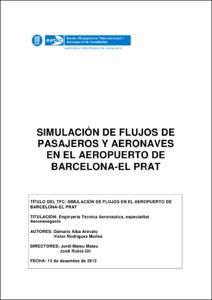Mostra el registre d'ítem simple
Simulación de flujos de pasajeros y aeronaves en el aeropuerto de Barcelona - El Prat
| dc.contributor | Mateu Mateu, Jordi |
| dc.contributor | Rubió Gil, Jordi |
| dc.contributor.author | Rodriguez Muñoz, Victor |
| dc.contributor.author | Alba Arévalo, Dámaris |
| dc.date.accessioned | 2013-06-26T08:57:37Z |
| dc.date.available | 2013-06-26T08:57:37Z |
| dc.date.issued | 2012-12-20 |
| dc.identifier.uri | http://hdl.handle.net/2099.1/18609 |
| dc.description.abstract | Un aeropuerto, y en especial uno grande como el Aeropuerto de Barcelona - El Prat, es una infraestructura extremadamente com pleja que tiene que estar muy bien planificada para que pueda asumir su máximo potencial. La simulación permite encontrar sus virtudes y defectos de manera que se hagan evidentes en la planificación, o que se puedan realzar, o solucionar, una vez está oper ativa. La principal ventaja de este trabajo es que el aeropuerto está funcionando, así que la interacción entre simulación y realidad puede ser bidireccional: la simulación se usa para comprender la realidad, y gracias a la toma de datos en condiciones re ales la simulación puede ser dimensionada adecuadamente. Antes de construir el modelo propiamente dicho, el aeropuerto ha sido analizado minuciosamente, y lo que deberían ser los datos devueltos por la simulación se han medido antes en la vida real para q ue coincidieran. Esto hizo que el trabajo se dividiera en dos grandes partes: movimien tos de pasaje y movimientos de aeronav es. Son suficientemente diferentes como para poder separarlos en dos simulaciones distintas, pero están conectadas; algo que ocurra en la terminal de pasajeros puede afectar la escala del avión, y viceversa. Pero como la simulación de los movimientos de aeronaves está centrada en el rodaje y no en la escala, se hizo necesario separar ambas simulaciones para simplificarlas. Los datos o btenidos con las simulaciones se han contrastado con los medidos in situ , para dimensionar y calibrar las simulaciones. Luego, se ha diseñado una interfaz para que sea posible entrar datos (por ejemplo, los de un plan de vuelos de un día particularmente in tenso) y sacar resultados (por ejemplo, los puntos donde habrá más congestión) sin necesidad de tener conocimientos de programación.Así, este trabajo, o la manera de hacerlo, puede ser útil en la gestión (o el diseño) de infraestructuras. |
| dc.description.abstract | An airport, and especially a big airport such as Barcelona - El Prat Airport, is an utterly complex infrastructure that has to be perfectly understood and really well - planned so it can meet its full potential. Through simulation, its virtues and flaws can be traced so that they can become obvious in planning stages, and be enhanced (or solved) once it is operational. The main advantage of this case study is that the airport is already o perational, so there can be a two - way interaction between simulation and reality: simulation can be used to understand reality, and thanks to real - life data collecting the simulation can be more accurately dimensioned. Prior to building the model itself, the airport has been thoroughly analyzed, and what was supposed to be the output data was first collected in real life so that it would match the results of the simulation. This lead to dividing the work in two big areas: passenger movements and aircraft m ovements. Both are different enough to be separated in two simulations, yet they are connected so that something happening in the passenger terminal can affect aircraft turnaround, or vice versa. But as aircraft simulation was focused on taxiing in and out of the terminal and not on the turnaround itself, it became necessary to separate both simulations in order to simplify them. Data collected from the simulations has been paired with the one obtained from real - life measurements, so that they could be cal ibrated and dimensioned according to these conditions. Then, and interface has been designed to make it possible to enter data (i.e. of a peak - day schedule) and get results (i.e., the places where congestion will occur) with no programming skills at all. This work may thus be useful in the design or management of new or existing infrastructure |
| dc.language.iso | spa |
| dc.publisher | Universitat Politècnica de Catalunya |
| dc.rights | Attribution-NonCommercial-ShareAlike 3.0 Spain |
| dc.rights.uri | http://creativecommons.org/licenses/by-nc-sa/3.0/es/ |
| dc.subject | Àrees temàtiques de la UPC::Aeronàutica i espai |
| dc.subject.other | Handling |
| dc.title | Simulación de flujos de pasajeros y aeronaves en el aeropuerto de Barcelona - El Prat |
| dc.type | Bachelor thesis |
| dc.rights.access | Open Access |
| dc.date.updated | 2012-12-21T06:29:34Z |
| dc.audience.educationlevel | Estudis de primer/segon cicle |
| dc.audience.mediator | Escola d'Enginyeria de Telecomunicació i Aeroespacial de Castelldefels |
| dc.audience.degree | ENGINYERIA TÈCNICA D'AERONÀUTICA, ESPECIALITAT EN AERONAVEGACIÓ (Pla 2003) |


